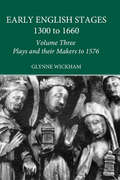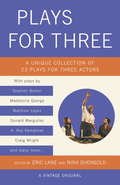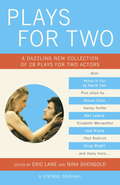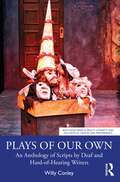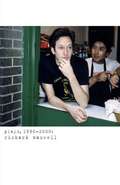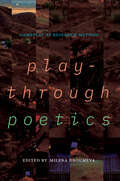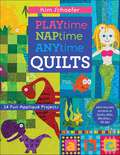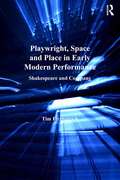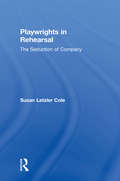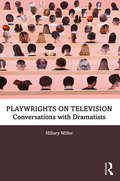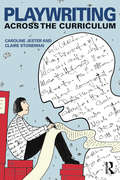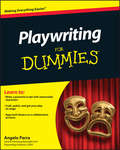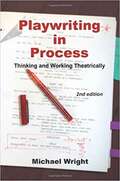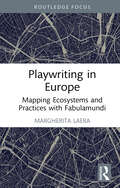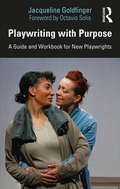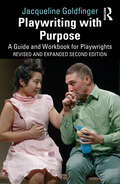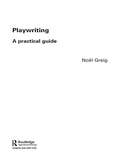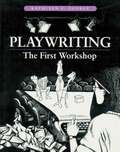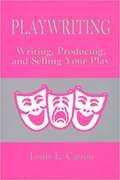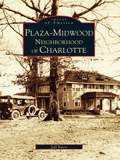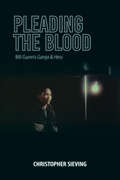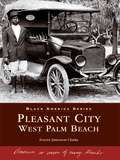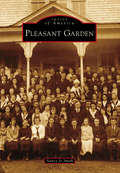- Table View
- List View
Plays and their Makers up to 1576
by Glynne WickhamThis volume forms part of the 5 volume set Early English Stages 1300-1660. This set examines the history of the development of dramatic spectacle and stage convention in England from the beginning of the fourteenth century to 1660.
Plays for Three
by Eric Lane Nina ShengoldPLAYS FOR THREE is a unique anthology of 23 outstanding plays for three actors by an exciting mix of established and emerging playwrights. Everyone's heard that "Two's company, three's a crowd." That may be true on a date, but on stage, three is a magic number. Add a third character to any interaction and the dramatic possibilities increase exponentially: suddenly there's competition, intrigue, shifting allegiances, comic misunderstandings, secrets and lies. Triangles make excellent drama, and three-handers offer the kind of substantial and challenging roles that actors love. Plays for Three offers six full-length and seventeen short plays featuring dramatic trios of every sort. Rob AckermanPete BarryStephen BelberCesi DavidsonAdrienne DawesPhilip DawkinsCatherine FillouxMadeleine GeorgeAmlin GrayFrank HigginsCory HinkleWendy KesselmanEric LaneKitt LavoieMark Harvey LevineMatthew LopezDonald MarguliesAnna MoenchA. Rey PamatmatDavid Riedy Nina ShengoldStephen WebbCraig WrightFrom the Trade Paperback edition.
Plays for Two
by Eric Lane Nina ShengoldPlays for Two is a unique anthology of twenty-eight terrific plays for two actors, by a mix of celebrated playwrights and cutting-edge new voices.It takes two to tango--or to perform a duet, fight a duel, or play ping-pong. The two-character play is dramatic confrontation stripped to its essence. These four full-length and twenty-four short plays feature pairs of every sort--strangers, rivals, parents and children, siblings, co-workers, friends, and lovers--swooning or sparring, meeting cute or parting ways. In a dizzying range of moods and styles, these two-handers offer the kind of meaty, challenging roles actors love, while providing readers and audiences with the pleasures of watching the complex give-and-take dynamics of two keenly matched characters.Plays by: Billy Aronson, David Auburn, Pete Barry, Naveen Bahar Choudhury, Anthony Clarvoe, Steven Dietz, Halley Feiffer, Simon Fill, Frank Higgins, David Ives, Jacob Juntunen, Ean Miles Kessler, Neil LaBute, Eric Lane, Kitt Lavoie, Jacqueline E. Lawton, Mark Harvey Levine, Elizabeth Meriwether, Michael Mitnick, Daria Polatin, Marco Ramirez, Kelly Rhodes, Jose Rivera, Paul Rudnick, Edwin Sanchez, Nina Shengold, Cori Thomas, Doug Wright From the Trade Paperback edition.
Plays of Our Own: An Anthology of Scripts by Deaf and Hard-of-Hearing Writers (Routledge Series in Equity, Diversity, and Inclusion in Theatre and Performance)
by Willy ConleyPlays of Our Own is the first anthology of its kind containing an eclectic range of plays by Deaf and hard-of-hearing writers. These writers have made major, positive contributions to world drama or Deaf theatre arts. Their topics range from those completely unrelated to deafness to those with strong Deaf-related themes such as a dreamy, headstrong girl surviving a male-dominated world in Depression-era Ireland; a famous Spanish artist losing his hearing while creating his most controversial art; a Deaf African-American woman dealing with AIDS in her family; and a Deaf peddler ridiculed and rejected by his own kind for selling ABC fingerspelling cards. The plays are varied in style – a Kabuki western, an ensemble-created variety show, a visual-gestural play with no spoken nor signed language, a cartoon tragicomedy, historical and domestic dramas, and a situation comedy. This volume contains the well-known Deaf theatre classics, My Third Eye and A Play of Our Own. At long last, directors, producers, Deaf and hearing students, professors, and researchers will be able to pick up a book of "Deaf plays" for production consideration, Deaf culture or multicultural analysis, or the simple pleasure of reading.
Plays, 1996-2000 (Maxwell)
by Richard MaxwellThis volume collects for the first time the work of one of America's most important, vital and original young voices. Turning the American family drama firmly on its head, "Maxwell strips more layers of explanation from the Freudian family romance, shining light on the humiliation and fury usually reasoned out of sight by psychologizing playwrights. Few characters in contemporary drama are as exposed as Maxwell's."--Marc Robinson, Village Voice"Imagine if you took a giant hatpin and stuck it into Sylvester Stallone's Rocky. Once all the hot air had leaked out of that melodrama about a working-class underdog who wins fame, fortune and love in the boxing ring, you might find something very much like Richard Maxwell's Boxing 2000. By taking a conventional formula and draining it of all its humid sentimentality and synthetic adrenaline, Mr. Maxwell discovers something new and unexpected. Boxing 2000 is a real knockout: a play that not only challenges theatrical clichés, but your ideas about theatre itself."--Wall Street Journal""It's a sensation that's felt all too rarely these days. Watching Mr. Maxwell's work makes you think of what it must have been like to stumble upon the baffling but seductive creations of a young Sam Shepard in the early 1960's in the East Village."--, New York TimesThis first volume collects nine of Maxwell's early works: Boxing 2000, Caveman, House (1999 OBIE Award winner), Showy Lady Slipper and others.Richard Maxwell is a writer, director and songwriter. He began his acting career with the Steppenwolf Theatre Company in Chicago, where he helped found the Cook County Theater Department, which challenged the principles of traditional acting training. He is artistic director of New York City Players. His plays have been performed in the U.S. at Soho Rep, The Kitchen, P.S. 122, HERE, the Williamstown Theater Festival, Walker Arts Center and the Wexner Center for the Arts; and in Paris, Berlin, Dublin, Brussels, Amsterdam and Vienna.
Plays, Movies, and Critics
by Jody McauliffeThis exceptional collection explores the mutual concerns of dramatic theater, film, and those who comment on them. Plays, Movies, and Critics opens with an original play by Don DeLillo. In the form of an interview, DeLillo's short play works as a kind of paradigm of the theatrical or cinematic event and serves as a keynote for the volume.DeLillo's interview play is accompanied in this collection by interviews with theater director Roberta Levitow, Martin Scorsese, and film/theater critic Stanley Kauffmann. Other contributions include a critical look at the current American theater scene, analyses of the place of politics in the careers of G. B. Shaw and Luigi Pirandello, a compelling reading of Chekhov's "The Seagull", a detailed inquiry into the obsessions that energize the works of Sam Shepard, provocative reinterpretations of the films Mean Streets and The Sheltering Sky, and a translation of André Bazin's important piece on theology and film.Contributors. André Bazin, Robert Brustein, Bert Cardullo, Anthony DeCurtis, Don DeLillo, Jesse Ward Engdhal, Richard Gilman, Jim Hosney, Mame Hunt, Jonathan Kalb, Stanley Kauffmann, Jody McAuliffe, Mary Ann Frese Witt, Jacquelyn Wollman, David Wyatt
Playthrough Poetics: Gameplay as Research Method
by Milena DroumevaGame streamers and live commentators are producing increasingly comprehensive analyses of gameplay, yet scholarship still tends to flatten the experiential media of video games into text for close reading. By shifting focus toward the immersiveness of video games, Playthrough Poetics makes the case for gameplay as a necessary, alternate method. Contributors to this volume engage widely with the activity of play through autoethnographies, meta-analyses of self-broadcasting, new procedural methods like gamespace soundwalking, as well as the affective aspects of games research. In doing so, they model new possibilities for academic players and gamers alike. Rigorous scholarship meets cultural practice in this innovative, multi-modal edited collection that includes video essays and offers transcripts of the playthroughs themselves. Readers (and viewers) will come away with a toolkit of models, case studies, and conceptual frameworks for analyzing video games through gameplay. This volume is a fresh return to the joy of play: the poetics of games as contemporary forms of storytelling and interactivity. With contributions from Ashlee Bird, Brandon Blackburn, Milena Droumeva, Kishonna Gray, Robyn Hope, Ben Scholl, Maria Sommers, Ashlyn Sparrow, Christine Tran, and Aaron Trammell.
Playtime, Naptime, Anytime Quilts: 14 Fun Appliqué Projects
by Kim SchaeferImaginative quilts for kids—make your child’s new favorite! Colorful spaceships, magical mermaids, and jungle friends—Kim Schaefer is back with more imaginative appliqué! The best-selling author of Quilts, Bibs, Blankies...Oh My! rolls out 14 quilts and more for kids and toddlers in her bold and graphic signature style. Stir your child’s sense of imaginative play with adorable naptime quilts, growth charts, placemats, wallhangings, floor cushions, and T-shirts made with machine appliqué and simple piecing. Full-size appliqué patterns are ready for you to trace or download. Kid-tested quilts in engaging designs are sure to become a favorite for tea parties and tent forts! • For boys, girls, and toddlers! Sew 19 appliqué quilts and projects in cheerful, kid-friendly themes • Quilts, wall hangings, growth charts, nap mats, placemats, floor cushions, and T-shirts • Full-size patterns for more whimsical motifs from the best-selling author of Quilts, Bibs, Blankies...Oh My!
Playwright, Space and Place in Early Modern Performance: Shakespeare and Company (Studies In Performance And Early Modern Drama Ser.)
by Tim FitzpatrickAnalyzing Elizabethan and Jacobean playtexts for their spatial implications, this innovative study discloses the extent to which the resources and constraints of public playhouse buildings affected the construction of the fictional worlds of early modern plays. The study argues that playwrights were writing with foresight, inscribing the constraints and resources of the stages into their texts. It goes further, to posit that Shakespeare and his playwright-contemporaries adhered to a set of generic conventions, rather than specific local company practices, about how space and place were to be related in performance: the playwrights constituted thus an overarching virtual 'company' producing playtexts that shared features across the acting companies and playhouses. By clarifying a sixteenth- to seventeenth-century conception of theatrical place, Tim Fitzpatrick adds a new layer of meaning to our understanding of the plays. His approach adds a new dimension to these particular documents which-though many of them are considered of great literary worth-were not originally generated for any other reason than to be performed within a specific performance context. The fact that the playwrights were aware of the features of this performance tradition makes their texts a potential mine of performance information, and casts light back on the texts themselves: if some of their meanings are 'spatial', these will have been missed by purely literary tools of analysis.
Playwrights in Rehearsal: The Seduction of Company
by Susan Letzler ColePlaywrights in Rehearsal is an inside look at the writer's role in the creative process of bringing his or her words to life on stage. Susan Letzler Cole, granted rare access to some of the major playwrights of our time, recounts her participation in rehearsal with Arthur Miller, Sam Shepard, Tony Kushner and Suzan-Lori Parks, and others.
Playwrights on Television: Conversations with Dramatists
by Hillary MillerPlaywrights on Television features interviews with writers of award-winning stage plays and celebrated television shows reflecting on the successes and challenges of being a playwright in the post-network television era. In these conversations, eighteen dramatists consider their professional paths and creative choices, from training and education to thoughts on craft and technique, and discuss a range of issues relevant to the development of dramatic writing today. Theatergoers and TV aficionados alike will find new perspectives on the journeys traveled by some of their favorite plays and series, such as The Affair, The Americans, Boardwalk Empire, GLOW, House of Cards, Insecure, Mad Men, Orange Is the New Black, Shameless, She’s Gotta Have It, Vida, and The West Wing. A valuable resource for aspiring stage and television writers, as well as theater and media scholars investigating the works of these dramatists, Playwrights on Television sheds light on the role of the contemporary playwright in the latest Golden Age of television.
Playwriting Across The Curriculum
by Claire Stoneman Caroline JesterFirst Published in 2012. Routledge is an imprint of Taylor & Francis, an informa company.
Playwriting For Dummies
by Angelo ParraThe easy way to craft, polish, and get your play on stage Getting a play written and produced is a daunting process. From crystallizing story ideas, formatting the script, understanding the roles of the director stagecraft people, to marketing and financing your project, and incorporating professional insights on writing, there are plenty of ins and outs that every aspiring playwright needs to know. But where can you turn for guidance? Playwriting For Dummies helps any writer at any stage of the process hone their craft and create the most dramatic and effective pieces. Guides you through every process of playwriting?from soliloquies, church skits, and one act plays to big Broadway musicals Advice on moving your script to the public stage Guidance on navigating loopholes If you're an aspiring playwright looking to begin the process, or have already penned a masterpiece and need trusted advice to bring it into the spotlight, Playwriting For Dummies has you covered.
Playwriting In Process: Thinking And Working Theatrically
by Michael WrightPlaywriting in Process: Thinking and Working Theatrically is written to encourage new and experienced playwrights to build techniques for a greater range of creative expression in writing for the stage. The book uses exercises to guide playwrights towards thinking and working theatrically. The exercises help playwrights start or revise their work by providing alternate ways of thinking about their subject and their processes. New to the second edition: new exercises, a general updating such as the use of the internet, a new chapter for teachers and playwriting group leaders on using this book in class, and end-of-chapter "Call Out" exercises. Useful for playwrights at all levels.
Playwriting in Europe: Mapping Ecosystems and Practices with Fabulamundi (Routledge Advances in Theatre & Performance Studies)
by Margherita LaeraThis book maps contemporary playwriting and theatre translation practices and ecologies in the European continent. Whether you are a scholar researching contemporary drama and translation, or a theatre practitioner looking for ways to navigate theatrical conventions in other countries, this book is for you. Through questionnaires and one-to-one interviews with key stakeholders, Dr Laera collects qualitative and quantitative data about how each national theatre culture supports living dramatists, what conventions drive the production and translation (or lack thereof) of contemporary plays, and what perceptions are held by gatekeepers, theatre-makers and other cultural operators about the theatre system in which they work. Through country-by-country descriptions and analyses; interviews with playwrights, translators, directors and gatekeepers; a list of key facts and best practices; and a rigorous assessment of its methodologies, this volume is indispensable for those interested in contemporary European theatre practice.
Playwriting with Purpose: A Guide and Workbook for New Playwrights
by Jacqueline GoldfingerPlaywriting with Purpose: A Guide and Workbook for New Playwrights provides a holistic approach to playwriting from an award-winning playwright and instructor. This book incorporates craft lessons by contemporary playwrights and provides concrete guidance for new and emerging playwrights. The author takes readers through the entire creative process, from creating characters and writing dialogue and silent moments to analyzing elements of well-made plays and creating an atmospheric environment. Each chapter is followed by writing prompts and pro tips that address unique facets of the conversation about the art and craft of playwriting. The book also includes information on the business of playwriting and a recommended reading list of published classic and contemporary plays, providing all the tools to successfully transform an idea into a script, and a script into a performance. Playwriting with Purpose gives writers and students of playwriting hands-on lessons, artistic concepts, and business savvy to succeed in today’s theater industry.
Playwriting with Purpose: A Guide and Workbook for Playwrights
by Jacqueline GoldfingerPlaywriting with Purpose: A Guide and Workbook for New Playwrights, Second Edition provides a revised and greatly expanded holistic approach to playwriting from an award-winning playwright and professor.This book incorporates craft lessons, scenes for study, and concrete guidance in both the art and business of playwriting. The author takes readers through the entire creative process, from creating characters and writing dialogue to revising and producing your play. Each chapter includes incisive craft lessons, provocative writing prompts, examples from plays, tips from working artists, reading recommendations, and more. Thoroughly revised, new features to this edition include: Vastly expanded sections on structure, world building, business of playwriting, writing for television and film, and more New writing exercises and pro tips from working playwrights in each chapter An exploration of art and craft through a new selection of international plays Shorter chapters with more subject headings to make it easier to find the exact craft lesson or writing prompt you want when you want it Playwriting with Purpose gives writers and students the tools to succeed in today’s theater industry.
Playwriting: A Practical Guide
by Noël GreigPlaywriting offers a practical guide to the creation of text for live performance. It contains a wealth of exercises for amateur and professional playwrights. Usable in a range of contexts, the book works as: a step-by-step guide to the creation of an individual play a handy resource for a teacher or workshop leader a stimulus for the group-devised play. The result of Noël Greig's thirty years' experience as a playwright, actor, director and teacher, Playwriting is the ideal handbook for anyone who engages with playwriting and is ultimately concerned with creating a story and bringing it to life on the stage.
Playwriting: The First Workshop
by Kathleen E. GeorgeThis is a practical introduction to the basic principles, structures and processes of writing plays. Beginning with simple concepts and exercises, this book gradually builds in complexity, until the reader is writing his or her one act play. Writing plays is unique because feedback, alternative approaches and discussion spur creativity. This book encourages this and thereby encourages the reader to write. The reader will discover how stage plays differ from screenplays, novels and television. The book also describes how autobiographical materials are transformed into playable parts, and how characters are moved by action. `Playwriting: The first workshop' gives readers the necessary background to begin working on their first play. Captures the workshop experience through writing, analyzing and testing plays. Contains synopsis and analysis of several well-known plays, such as `The Dining Room'. Each chapter provides study questions and exercises that reinforce important concepts.
Playwriting: Writing, Producing And Selling Your Play
by Louis E. CatronA practical guidebook for effective playwriting! This imaginative and enthusiastic book is designed especially for those having the desire to create, to entertain, and to express their emotions and ideas. It features a practical, down-to-earth emphasis on craft and structure rather than on theory as its step-by-step approach shows just what’s involved in creating a stageworthy play. Coverage includes basic considerations such as plot and character development, theme and dialogue as well as production and publication considerations. Outstanding features: offers concrete writing guidelines; includes exercises that get the reader going and inspirational anecdotes; presents excerpts from such classics as Macbeth, The Glass Menagerie, and The Dumb Waiter that help the student grasp key concepts; lists plays to read for instruction; includes valuable information not usually found in comparable collections.
Plaza-Midwood Neighborhood of Charlotte
by Jeff ByersOne of Charlotte's early streetcar suburbs, the Plaza-Midwood neighborhood epitomizes the New South vision of Charlotte. Its history reflects the growing of the New South and the nation as a whole. Plaza-Midwood, known for its architectural and social diversity, has been through the years a proposed enclave for Charlotte's New South elite, an "at risk" inner city area, and ultimately an urban success story. Plaza-Midwood's current prosperity can be attributed to the strength and vision of its "citizens," who continue to preserve the character and history of their community. Plaza-Midwood owes its survival to a dedicated neighborhood organization. Through their efforts, much of the area has been declared an historic district.
Pleading the Blood: Bill Gunn's <i>Ganja & Hess</i> (Studies in the Cinema of the Black Diaspora)
by Christopher SievingThe definitive look at one of the most important Black art films and original filmmakers of the 1970s.Bill Gunn's Ganja & Hess (1973) has across the decades attained a sizable cult following among African American cinema devotees, art house aficionados, and horror fans, thanks to its formal complexity and rich allegory. Pleading the Blood is the first full-length study of this cult classic. Ganja & Hess was withdrawn almost immediately after its New York premiere by its distributor because Gunn's poetic re-fashioning of the vampire genre allegedly failed to satisfy the firm's desire for a by-the-numbers "blaxploitation" horror flick for quick sell-off in the urban market. Its current status as one of the classic works of African American cinema has recently been confirmed by the Blu-ray release of its restored version, by its continued success in screenings at repertory houses, museums, and universities, and by an official remake, Da Sweet Blood of Jesus (2014), directed by Spike Lee, one of the original picture's longtime champions.Pleading the Blood draws on Gunn's archived papers, screenplay drafts, and storyboards, as well as interviews with the living major creative participants to offer a comprehensive, absorbing account of the influential movie and its highly original filmmaker.
Pleasant City, West Palm Beach
by Everee Jimerson ClarkePleasant City, a neighborhood of West Palm Beach, Florida, is the oldest African-American community in Palm Beach County. The first black settlers came to a place called the Styx--later owned by white millionaires who then rented their backyards to black workers--to work on the railroad and Henry Flagler's hotel and mansion. Forced out when the land became valuable, the blacks purchased land and settled Pleasant City. Pleasant City was marketed as a "High Class Colored Subdivision" in 1913, and many of the pioneers still have descendants in the area today.
Pleasant Garden (Images of America)
by Nancy Jo SmithThe 20th century brought dramatic change to the closely knit yet independent-minded farming community of Pleasant Garden, North Carolina. Although descendants of the families who migrated from the Eastern Shore of Maryland still lived on the lands of their ancestors and attended Pleasant Garden Methodist Episcopal Church, which was organized in 1788, they welcomed progress. The community became home to one of the first state-supported high schools, and the Pleasant Garden Company built manufacturing businesses alongside the Atlantic & Yadkin Railroad, where eight trains passed each day. These improvements created a ripple effect of development that began with housing needs for students, faculty, and employees. Following World War II, the community no longer had passenger trains; however, new factories relied on rail service. These industries found qualified employees from the surrounding community. As housing developments and recreational and retail opportunities evolved, and as many baby boomer families began commuting to nearby cities for work, Pleasant Garden became a bedroom community. In 1997, it incorporated as a town.

